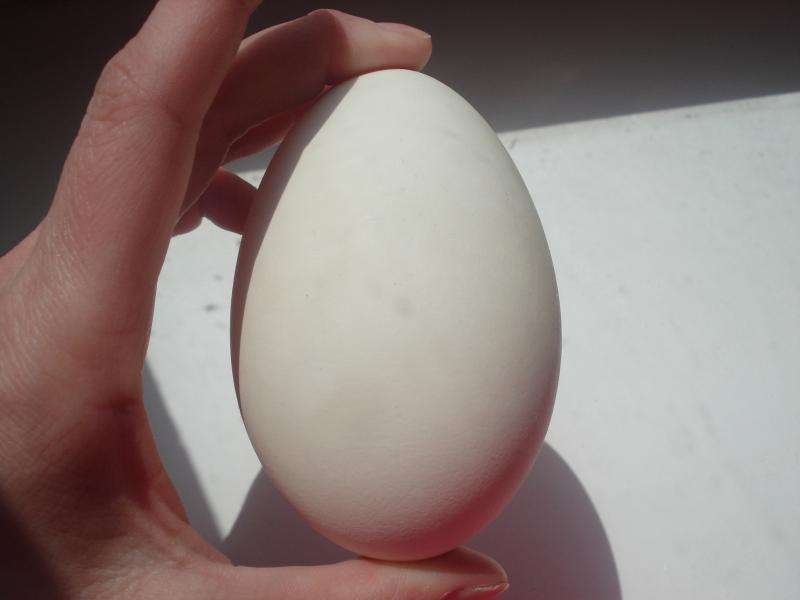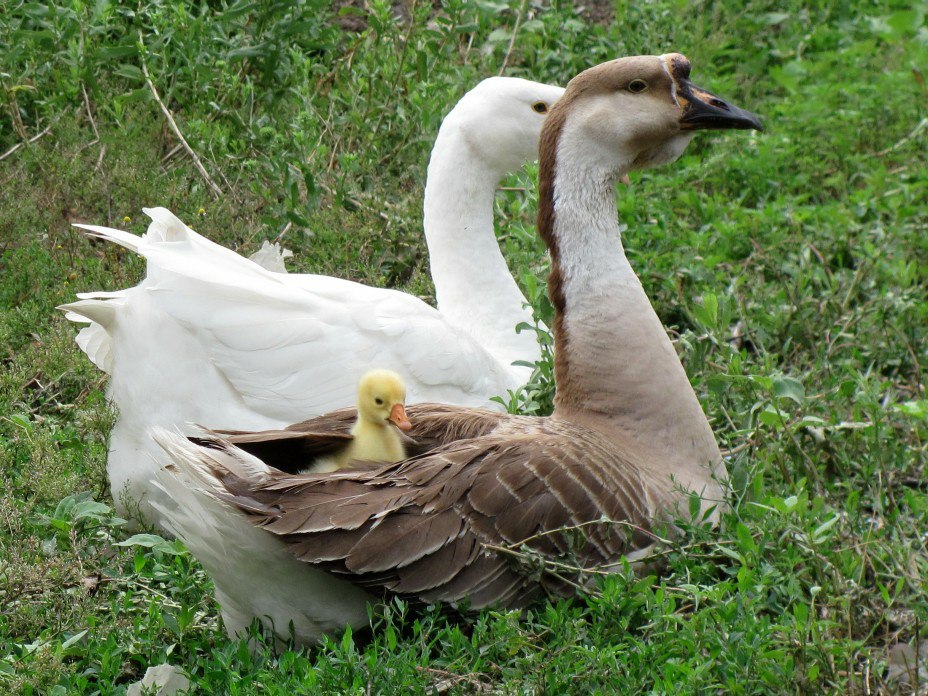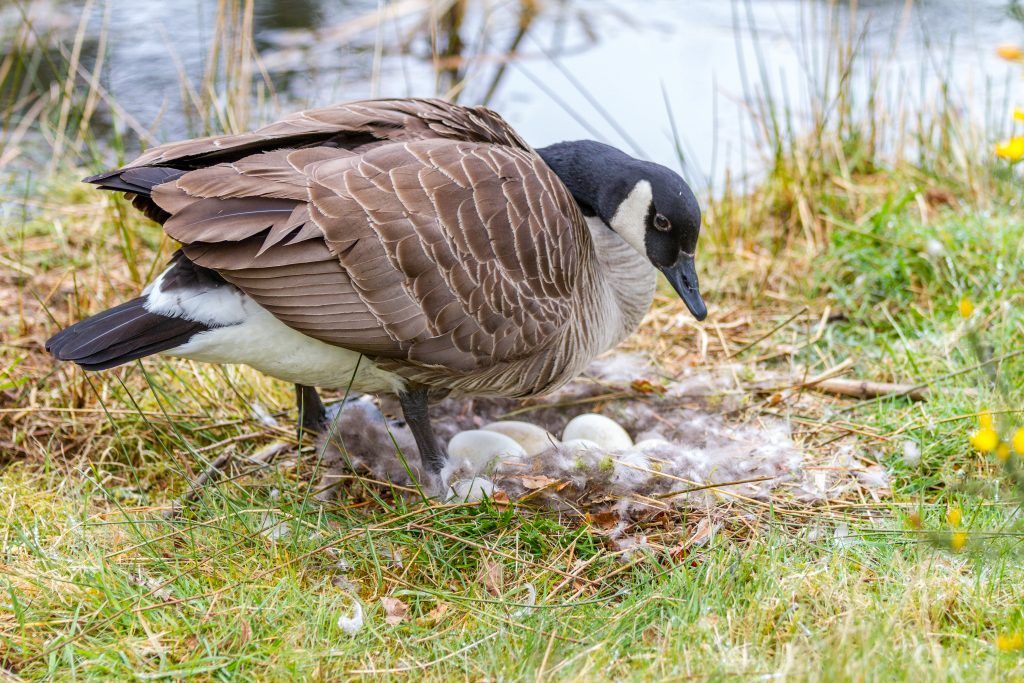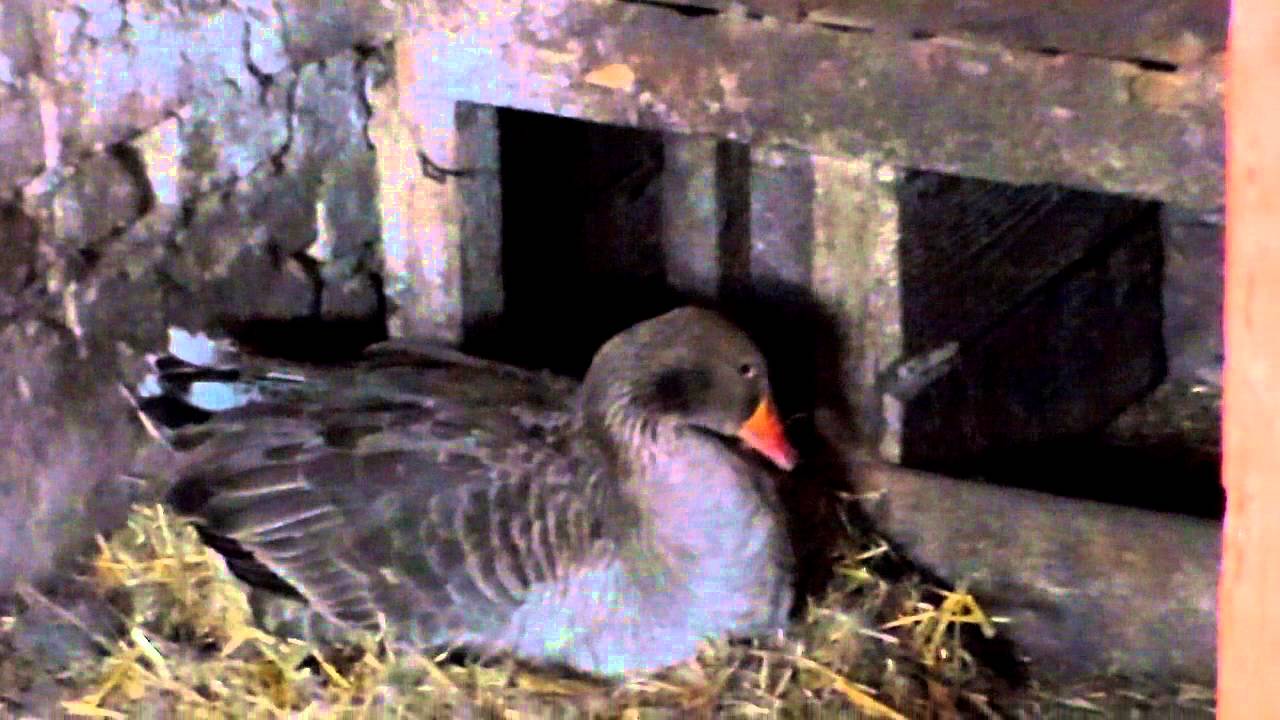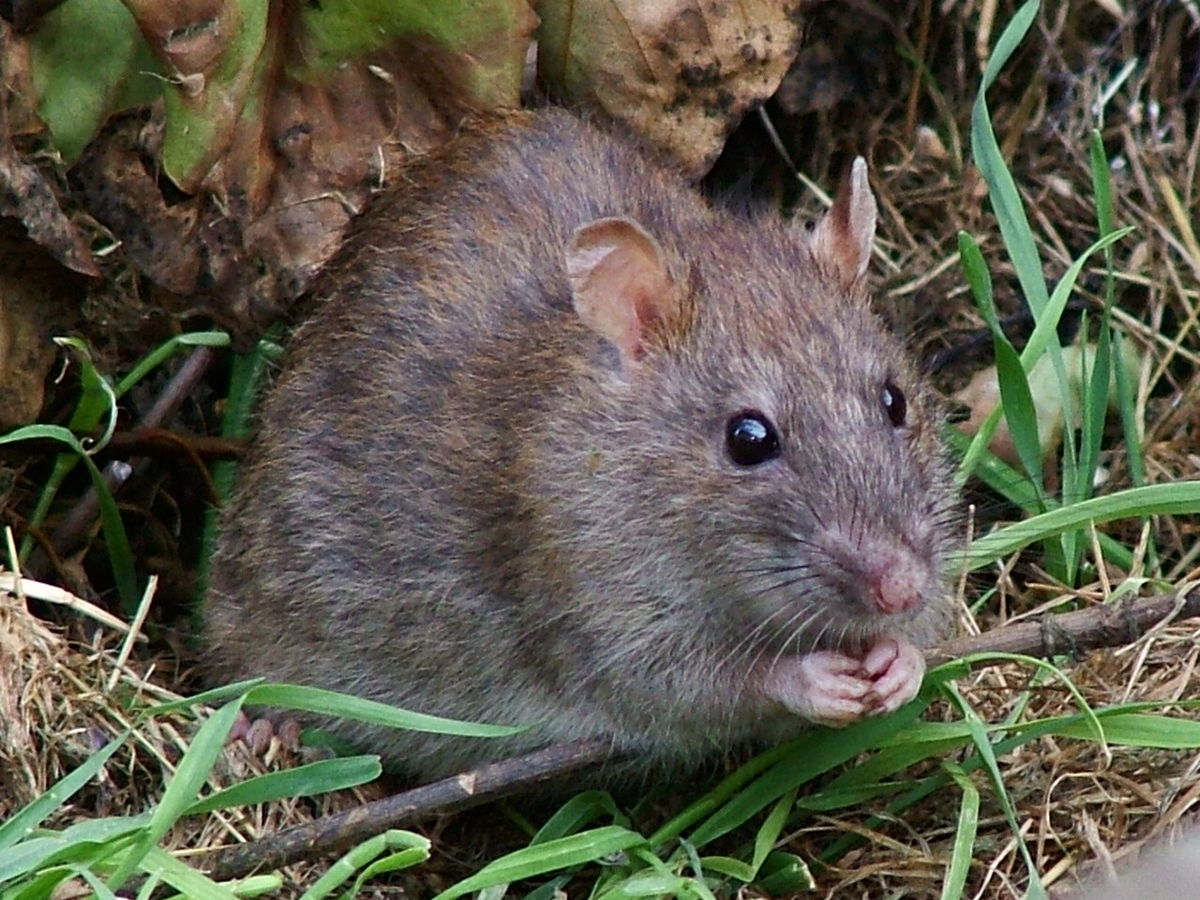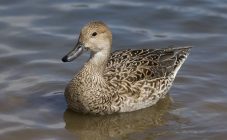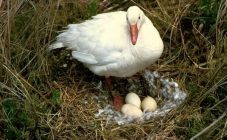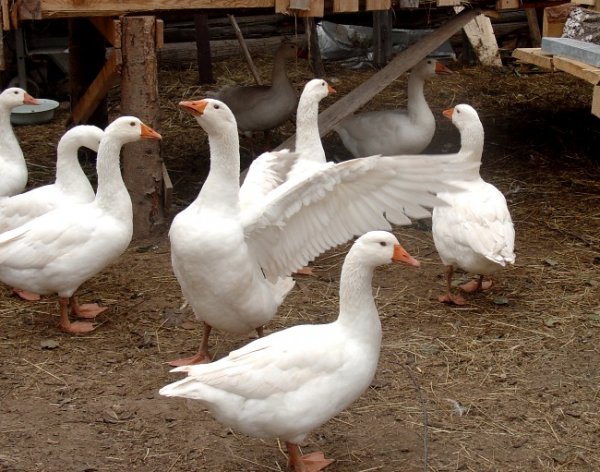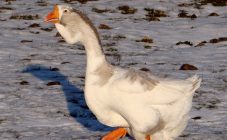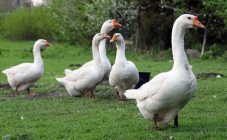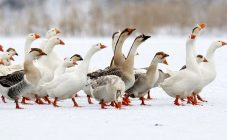Content:
- How many days do geese hatch eggs
- How many eggs does a goose hatch: correct selection
- Good time for "planting" geese
- What you need to know about the nest preparation process
- How to put a goose on eggs
- Features of laying hens
- The goose sat on eggs: how to care
- FAQ
- Tips for dealing with rats and small predators
- Rules for keeping hatched goslings
Geese are bred for delicious meat, eggs and feathers (down). Man tamed this unpretentious large bird earlier than other domestic birds. Despite this, even when keeping at home, they show more freedom of love than chickens later domesticated. With the right content, the likelihood of breeding your goslings is very high. In geese, unlike chickens, the incubation instinct is preserved. What ratio of males and females should be in the herd, when the geese begin to lay, how many geese sit on the eggs need to be studied before starting a bird.
How many days do geese hatch eggs
Geese are late maturing birds. Females begin to produce an egg at 8-9 months of age. How many days a goose sits on eggs depends on their size and quantity. The incubation period for goose eggs is 28 days. In reality, this period increases to 30-32 days. In order for the goslings to be born as a friendly brood, the eggs in the nest should be regularly turned and shifted. This will ensure their uniform heating from all sides.
How many eggs does a goose hatch: correct selection
The goose can hatch as many eggs as its size allows: from 10 to 15 pieces. Collecting eggs for future incubation lasts an average of 10 days, but no more than 20. A medium size (160 g) is selected, since small chicks will appear from small ones, which will lag behind in growth and will not gain sufficient live weight. Large eggs may end up with two yolks and none of them will hatch. Cracks, irregularities, rough shells, and various growths are subject to rejection. It is not recommended to take an egg that is too contaminated, as the bacteria contained in the droppings can harm the embryo. The optimal collection time is about 12 noon, when the geese have already been laid, the testicle is not damaged, not dirty and not too cold. Dirty (in case of deficiency) can be washed, but only before the incubation itself.
Storage conditions:
- in the "on the side" position (turn over every 2 days);
- air temperature 10-15 ° С;
- humidity - from 70%;
- without direct sunlight.
The percentage of hatchability for goslings decreases sharply with increasing shelf life:
- 5 days - 80%;
- 10 days - 73%;
- 15 days - 54%;
- 20 days - 33%;
- 25 days - 0%.
Good time for "planting" geese
The life cycle of a goose is closely related to nature. Their reproductive instinct depends to a greater extent on the season and falls on the spring. At the end of March, the birds begin to molt and the females collect the fallen feathers, putting them in the nest, prepare a place for incubation. The owner, planning to hatch goslings, should carefully look at the birds, choosing suitable hens. Young females get nervous, tread on one place, sit on a nest with one egg.
How to choose a goose for hatching chicks
The bird, which is assigned the role of the hen, must be absolutely healthy and have a calm, kind disposition. An adult bird that already has experience in raising chicks is more suitable for incubating chicks. Such a goose behaves much more carefully and becomes a caring mother. If there are only pullets on the farm, then you should carefully observe the behavior of the birds:
- good brood hens less often than others;
- the goose, having laid an egg, does not leave the place of laying, but begins to tinker with the nest, laying it out with its down. Such birds are reluctant to leave the nest, preferring to spend most of their time in it;
- sitting in a prepared place, she does not jump up when a person approaches, but begins to hiss and flap her wings, trying to pinch, protecting her clutch;
- noticing this behavior, you can lay eggs collected in advance for the goose. It is important to make sure that the first goose demolished it in the nest. After she will lay all her eggs in one place;
- occasionally, in the absence of the incubation instinct, the goose has the opportunity to use a chicken as a brooding hen, placing no more than 5 goose eggs under it.
What you need to know about the nest preparation process
The nest should be prepared in advance before the laying period begins. They do this at the end of winter. It is important that the female independently chooses the place where she is ready to incubate the clutch. During this period, the bird needs peace and comfort. A cozy nest away from someone's eyes is the key to a good hatching of chicks. The goose should not see "friends" or other birds, and the appearance of a person is also undesirable. All this makes the bird nervous and may even lead to the fact that it leaves its home.
When multiple birds are planned to be planted, the number of prepared sites must be larger to give the birds a choice. The nests are placed on the ground (floor), after having placed a durable material that is not subject to decay (for example, foam) and insulated the lower part. The house should be clean, free of trash, and the birds should not have difficulty accessing food and nest.
Materials for making a nest can be very different, including improvised means: tires, boxes, boxes, pieces of furniture. Hay, straw, polystyrene, moss and other heat-insulating materials are used for insulation. The flow of light into the room should be limited (close the windows), and the electricity should be turned on as needed. The house where eggs are to be hatched should be free from drafts and dampness. The size of the nest corresponds to the size of the goose, as these are large birds (approximately 70 cm (width) x 60 cm (height) x 70 cm (length)).
It is desirable that there is a body of water nearby, and the bird has the opportunity to swim and go to the toilet. The reservoir is also useful for future offspring.
How to put a goose on eggs
Cases when geese refuse to hatch a clutch are very rare. Their maternal instinct is very high. If, nevertheless, an obstinate bird is caught, you can cope with the situation:
- do not try to seat large, meat breeds: Rhine, Adler, Emden. They are not the best ones for brooding. A large mass leads to mechanical damage to the eggs;
- check the conditions and quality of the nest: a secluded, cozy and dark place, room temperature 13-17 ° С, free access to food and water;
- cover the bird with a box (box) or block the exit, leaving it there for several days (release for feeding). This method doesn't always work, but you can try;
- The easiest way to get a goose to sit on eggs is to show her a nest with a full clutch of eggs, or simply not collect those that she laid in a few days.
If the bird settles on the nest, the first few days it may refuse food. In such cases, the goose is carefully removed from the clutch and taken to the feeder. Birds leave the nest for a maximum of 20-25 minutes.
Features of laying hens
Geese are bred on farms for meat, egg productivity in these birds is low and shifted to the spring-summer period. In terms of parental qualities, geese differ from other poultry:
- They are sensitive to the clutch: several eggs in the nest awaken the instinct of the brooding hen in them, which is used by the owners to forcibly plant the bird on the nest.
- adult geese (1.5-2 years old) are able to lay eggs of better quality;
- getting up from the nest, a caring mother covers the clutch with her feathers and twigs. This should protect the eggs from thieves and keep them from getting too cold;
- how much the goose incubates the eggs, it always turns them over, rolls them, swapping them so that they are evenly warmed from all sides. In this she can be helped by moving them from the center to the edges and vice versa;
- low egg production and a well-developed maternity instinct are directly related. Such breeds of geese retain fertility longer than others (5-6 years);
- geese usually lay every other day, occasionally lay eggs daily. During the laying period, the goose lays 15-30 pieces.
The goose sat on eggs: how to care
When the process has started, this does not mean that the owner should not participate in it. On the contrary, he has a great responsibility.
- During the incubation period, the bird needs to be surrounded with unobtrusive care, all actions for checking the eggs and cleaning should be done in the absence of the female.
- The hen is kept separate from the rest of the livestock so that other geese do not lay eggs in the nest during the absence of the hen.
- Provide constant access to feed and water. The goose should not run and seek food. She gets out of the nest only for the sake of feeding.
- There should be a pond or bathing tank near the nest. The goose swims, cleans, wet feathers moisten the eggs, which will facilitate the hatching process for the chicks.
- The owner himself can moisten the eggs by sprinkling water on the clutch while the mother goose went to feed.
- You should check the fertilization of the eggs by shining through them with an ovoscope (you can use an ordinary flashlight) after 8 days of incubation. If the embryo is absent (light and transparent liquid when translucent), the egg is removed from the clutch so that the rest are heated better. The last examination is carried out before hatching - on days 28-29. Eggs with frozen embryos are removed.
- Eggs rolled out from under the hen, “cuffs”, cracked and crushed ones are also removed from the nest.
- The hens should be fed with grain, removing wet food, greens, mash from the diet, which can provoke diarrhea.
- The house is cleaned regularly.
FAQ
Often, beginners do not know how to act in a given situation, so they have many questions:
What to do if a goose buries eggs but does not sit down
Geese bury their eggs in the litter, obeying instinct. The hen will sit on the nest when there are at least 5 eggs in it. To prevent the first ones from freezing, the female hides them, insulates them. Geese are not stupid birds. The female can hide eggs from the hosts who collect them.
Will it be possible to put chicken eggs in the nest
If you put chicken eggs under a goose, can you expect healthy offspring? It is not recommended to do this, since a large hen can crush eggs that have a shell much thinner than a goose.
Why does the goose throw eggs
There are times when a brood goose rolls out eggs from the nest. The reason may be:
- an excessive number of eggs in the clutch, and the goose instinctively realizes that it cannot warm everything;
- the bird independently identifies and removes eggs with frozen embryos, unfertilized and spoiled ones.
Tips for dealing with rats and small predators
The problem is easier to prevent than to deal with. When building a poultry house, some rules should be followed:
- pour a layer of rubble on the ground, mixing it with broken glass - a reliable remedy against rats;
- in a wooden building, upholstery walls from below with iron sheet;
- Pour wood ash from the oven near the holes, as rats cannot stand it;
- the smell of some plants will scare away gray rodents: onions, wild rosemary, legumes;
- poisonous plants - nightshade, raven eye, aconite can be thrown into holes, but at the same time make sure that poultry does not taste them;
- the smell of burnt wool or feathers can drive away any beast;
- a hedgehog can easily cope with rats if he lives next to the poultry house.
Rats are unpleasant neighbors that can carry infection, but they cannot steal eggs or goslings. Much more dangerous are small predators such as weasel, ferret, marten or ermine. These graceful weasels can easily penetrate any crevices and cracks. Despite their small size, the animals are famous for their bloodthirsty disposition. Various traps and traps are used to combat them. To prevent entry into the house, the foundations, walls and windows are regularly checked for intrusion points. As an old folk remedy, it is proposed to keep a large dog with long hair or an uncastrated adult goat in the barn. Unexpected guests hate their smell.
Rules for keeping hatched goslings
Breeding goslings under a brood hen is the cheapest way of reproduction, which is easy to practice in a small population. Geese sit on eggs until they hatch as long as necessary. The hen will independently take care of the chicks and teach them all the wisdom. Very little is required from the owner:
- a chick that cannot get out of the egg on its own needs help by removing the stuck shells around the edges;
- the hatched chicks are collected in a separate box and placed in a warm place, and after the end of the hatching, the children are returned to their mother;
- chicks are kept on dry and clean bedding;
- the temperature should not be lower than 30 ° C, which is provided by the female herself. In cases of a sharp drop in air temperature or unforeseen circumstances, include heaters;
- for 1-2 days, the goslings are given a boiled egg and oatmeal, after which they are transferred to chopped greens and vegetables;
- you can release a brood for a walk from the second day of life, excluding cold and rainy days, since goslings are very sensitive to fluctuations in temperature and humidity;
- a walking area is arranged near the nest, providing it with a reservoir or a trough with water. The goose herself will teach her offspring everything, and in the evening she will take them home.
The goose is a popular bird in the household. Geese are especially often bred in settlements located on the banks of reservoirs (lakes, rivers). With minimal care, the owners have the opportunity to obtain offspring and a good yield of meat products. When planning the breeding of geese, you need to determine the breed and the number of heads, and then equip the poultry house and walking area.
